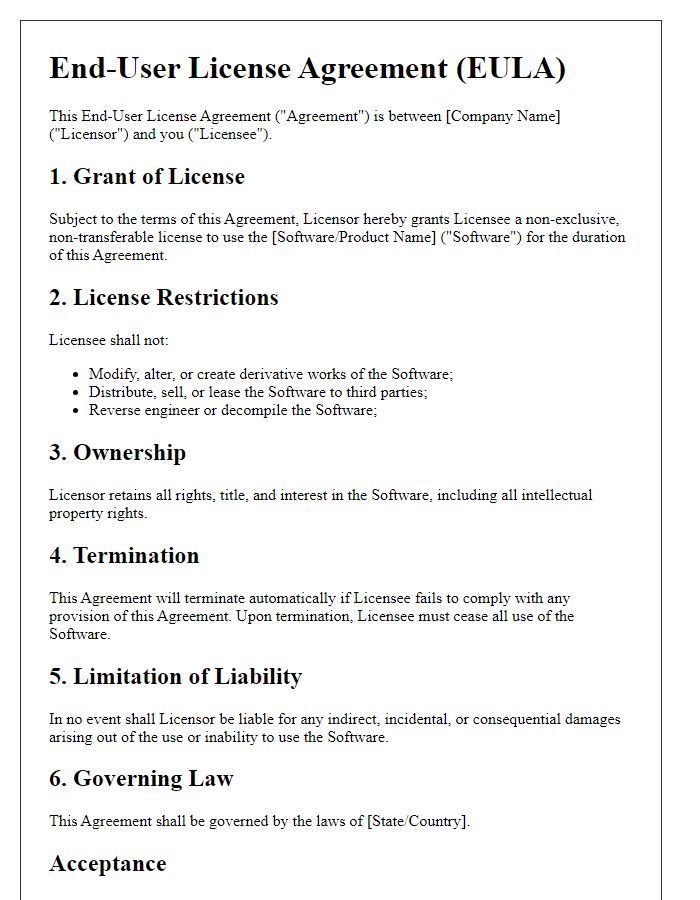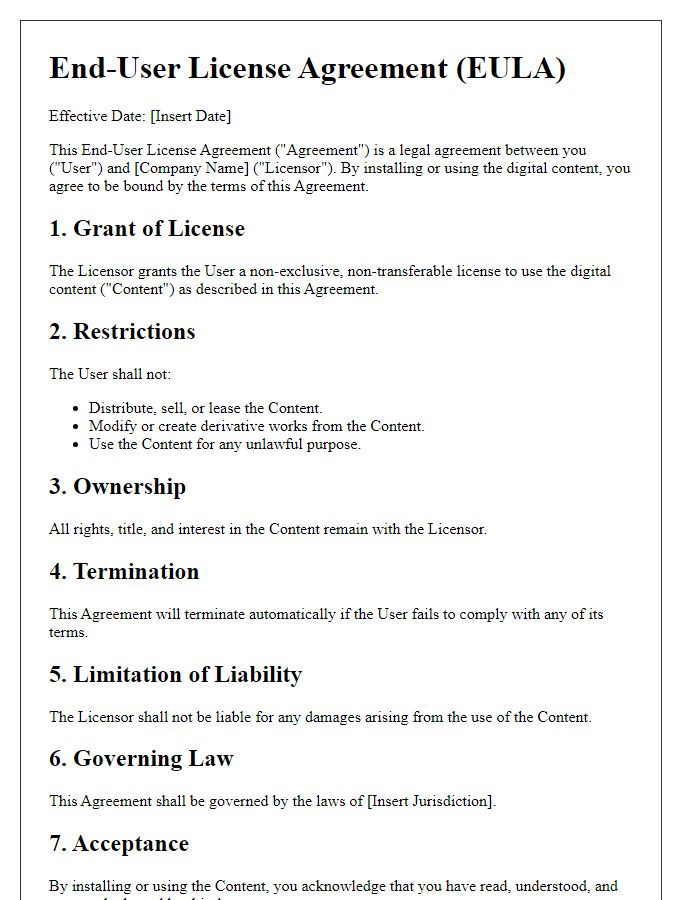Are you looking for a clear and concise template for an End-User License Agreement (EULA)? Crafting a legal document can often feel overwhelming, but having an effective template can simplify the process and ensure all parties are on the same page. In this article, we'll walk you through the essential components of a EULA, making it easier for you to tailor it to your specific needs. So, let's dive in and explore the details that will protect both your rights and those of your users!

Grant of License and Usage Rights
The End-User License Agreement (EULA) outlines the specific permissions granted to users regarding software usage, emphasizing the legal relationship between the software developer (often a corporation or individual) and the end-user. This agreement typically includes clause definitions, focusing on the type of license, whether it is permanent or temporary, and stipulates the allowed usages, such as installation on a certain number of devices (often limited to one or two) and prohibiting actions, including redistribution, modification, or reverse engineering of the software. Unique license identifiers, which serve as digital keys for software activation (usually alphanumeric strings), may be discussed to ensure software integrity. Users may also be reminded of the importance of complying with copyright laws to avoid legal repercussions. Furthermore, the EULA specifies any conditions under which the license may be terminated, allowing the developer to enforce their rights effectively. Compliance with these terms assures the user of their legal use while protecting the developer's intellectual property.
Restrictions and Limitations
Restrictions and limitations within an end-user license agreement (EULA) govern how software, such as proprietary applications or digital content, can be used by third-party users. These restrictions may include prohibitions against unauthorized distribution, reverse engineering, and modifying source code, typically ensuring that intellectual property rights remain intact for the software developer or publisher. Specific limitations may dictate the number of devices allowed for installation or the duration of license validity, often indicating that a license is non-transferable. Violating these terms can lead to legal consequences, including penalties or termination of access to the software. Understanding these restrictions is crucial for compliance and protecting the user's interests in legal contexts.
Intellectual Property Rights
Intellectual Property Rights (IPR) govern the ownership and use of creations and inventions, profoundly impacting software and technology industries. Copyright (a legal right granting the creator exclusive control over reproduction and distribution) protects original works, including code and documentation, while patents (which grant exclusive rights to inventors) cover innovations and technical solutions in products. Trademarks (symbols, names, or slogans) identify and distinguish goods or services, ensuring brand recognition. Licensing agreements (legal contracts) provide users with permissions to use software while stipulating limitations to protect the creator's rights. Violations of IPR can result in legal consequences, including litigation costs and penalties, underscoring the importance of understanding and adhering to these regulations.
Termination Conditions
Termination conditions in an end-user license agreement (EULA) outline specific scenarios where the agreement may be ended or revoked. Users must understand that failure to comply with the agreed terms, such as unauthorized distribution of software or failure to pay required fees, could lead to immediate termination. Additionally, major breaches like engaging in illegal activities or violating intellectual property rights will result in termination. After termination, users must uninstall the software and cease all usage immediately. The company reserves the right to pursue legal action for any damages incurred due to violations. Users should also be aware of the potential for reinstatement under certain conditions upon rectification of issues.
Limitation of Liability and Disclaimers
The Limitation of Liability clause in an end-user license agreement establishes boundaries around the liability of the software provider. A key aspect, often specified in sections detailing financial caps, may limit damages to the amount paid for the software, thus avoiding potential bankrupting claims. Disclaimers serve to clarify the absence of warranties, indicating that the software may contain errors, defects, or interruptions. This section often draws attention to specific activities, such as consequences of using the software outside of intended purposes. Legal guidelines (such as the Uniform Commercial Code in the United States) often govern these stipulations, creating a framework to protect developers while informing users of risks associated with software usage, ultimately fostering a clearer relationship.













Comments